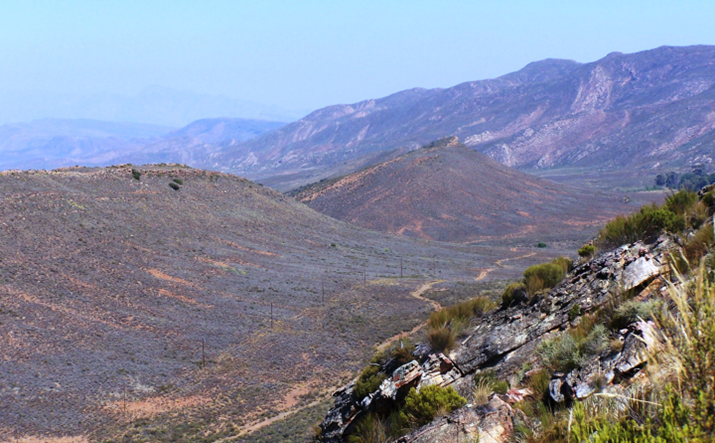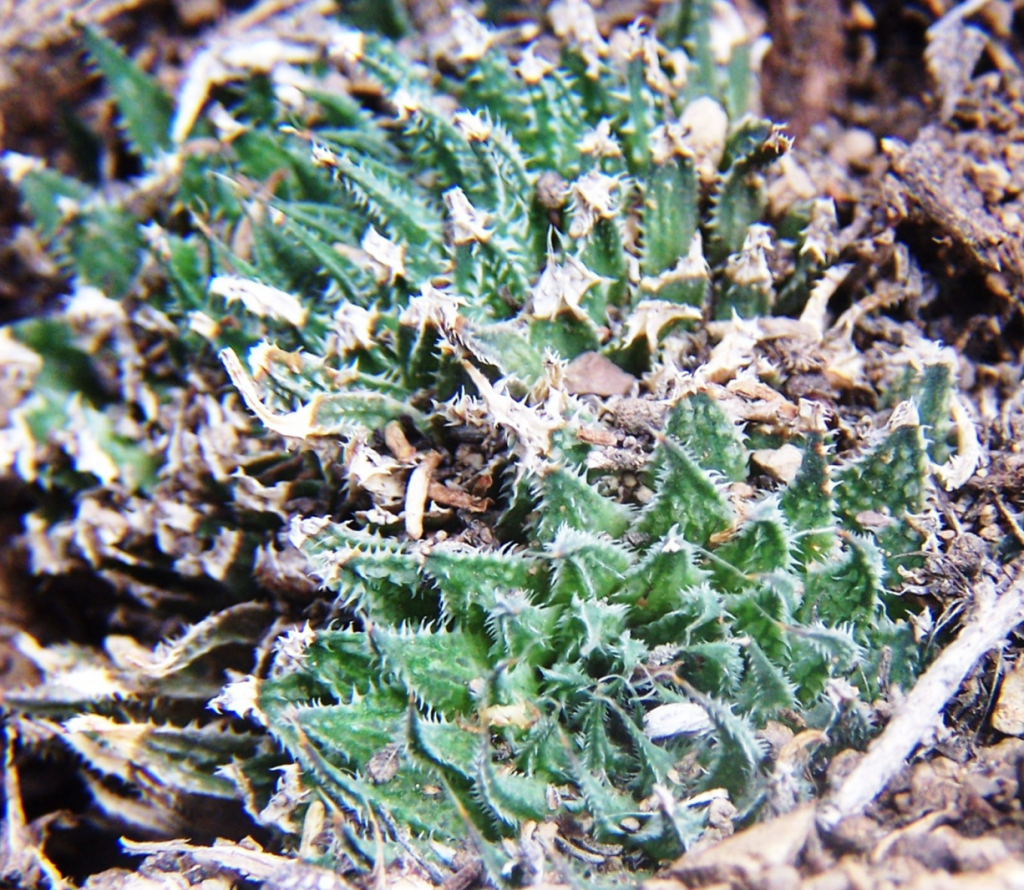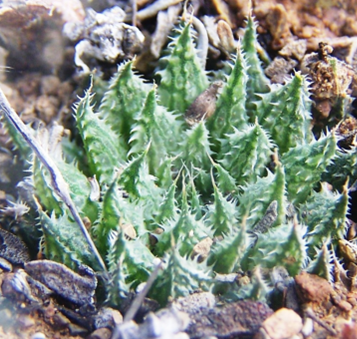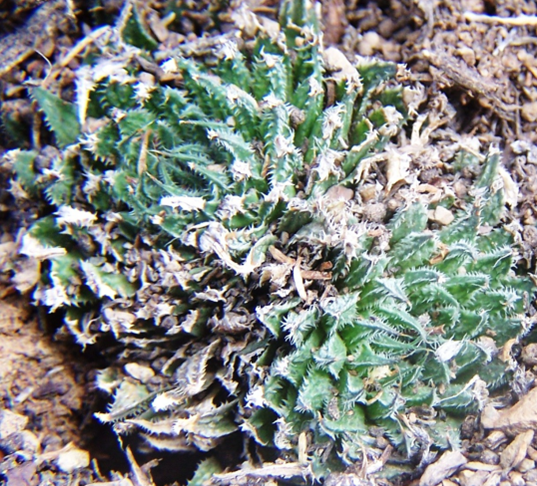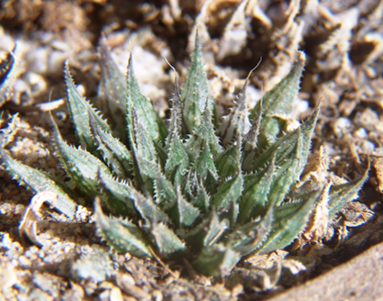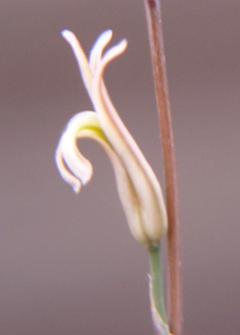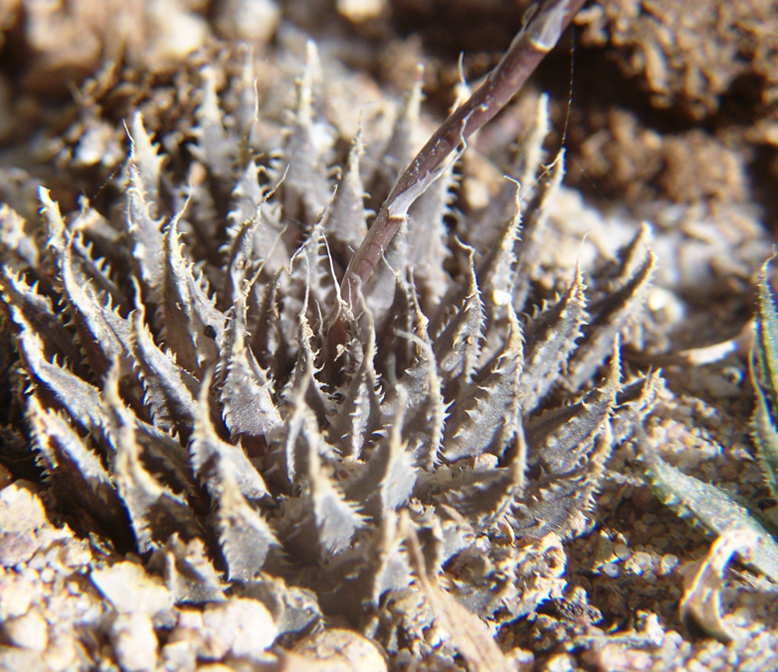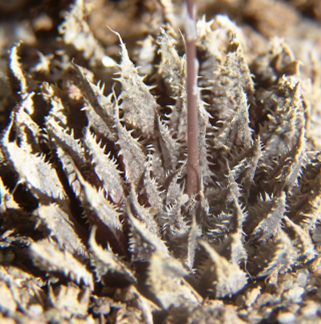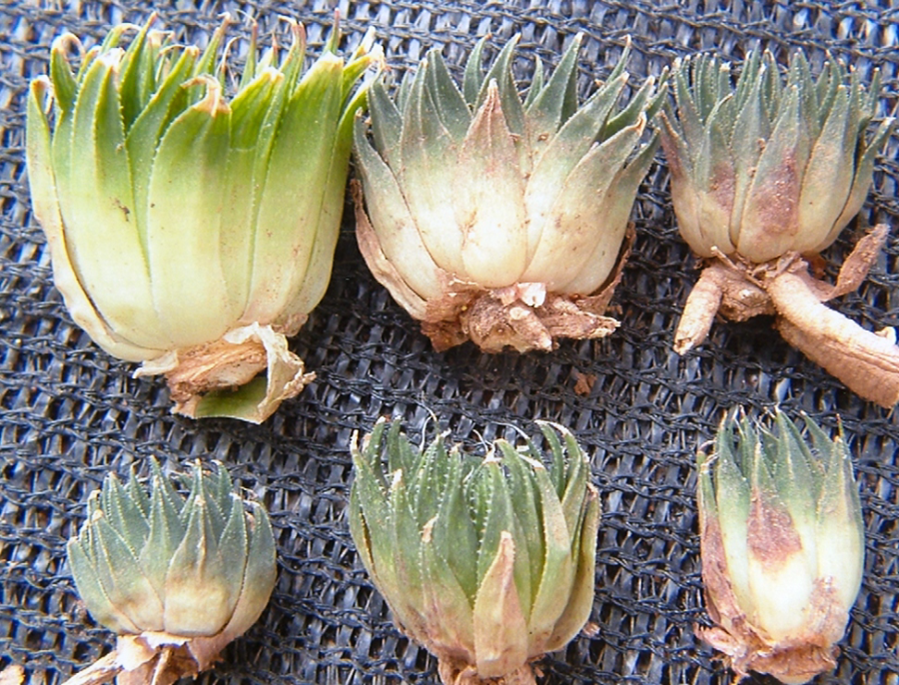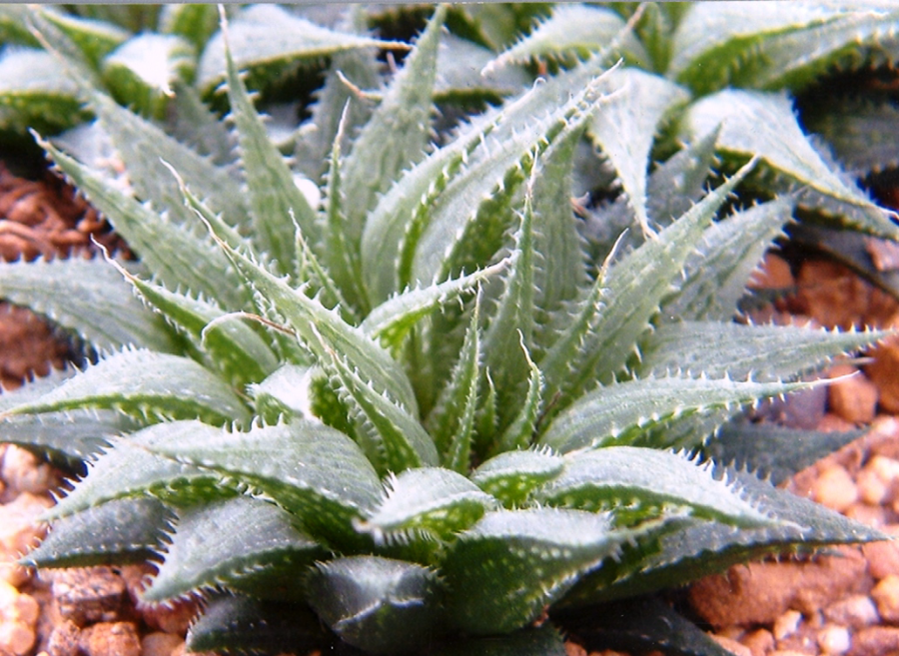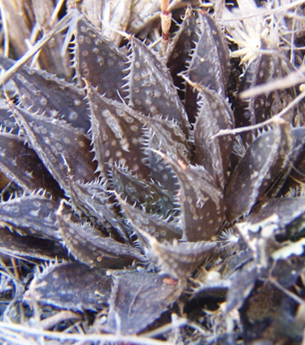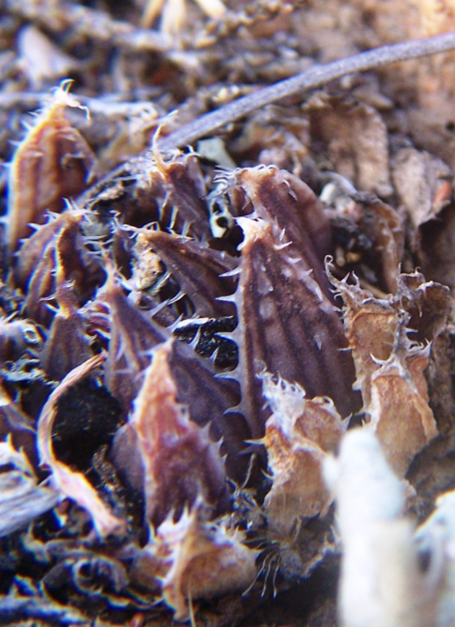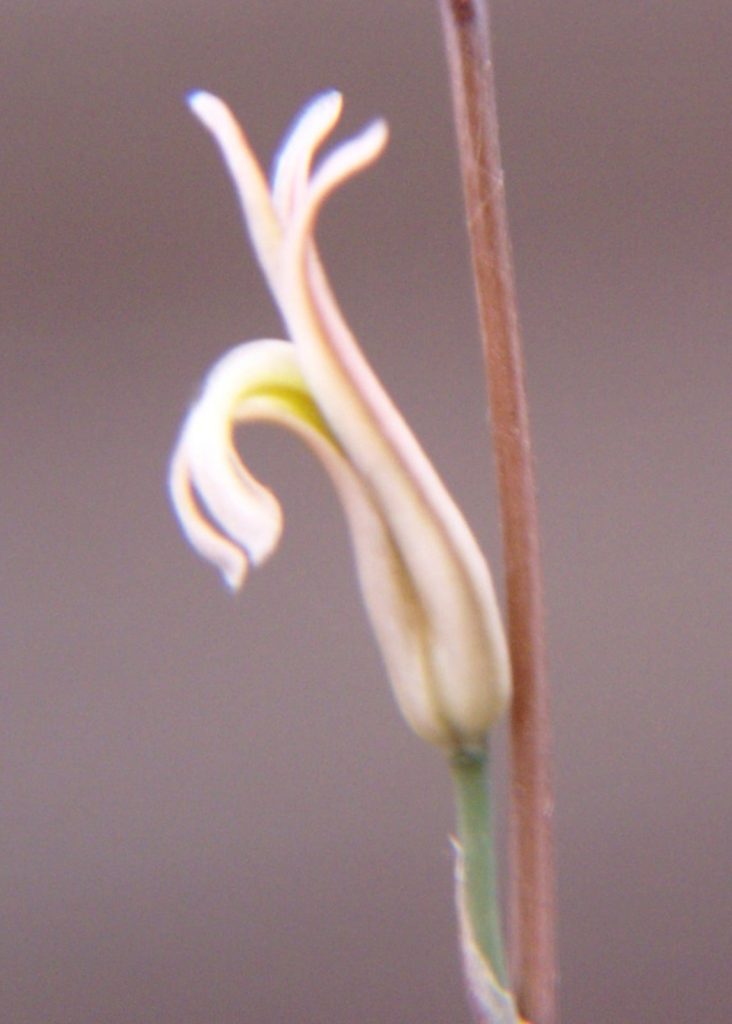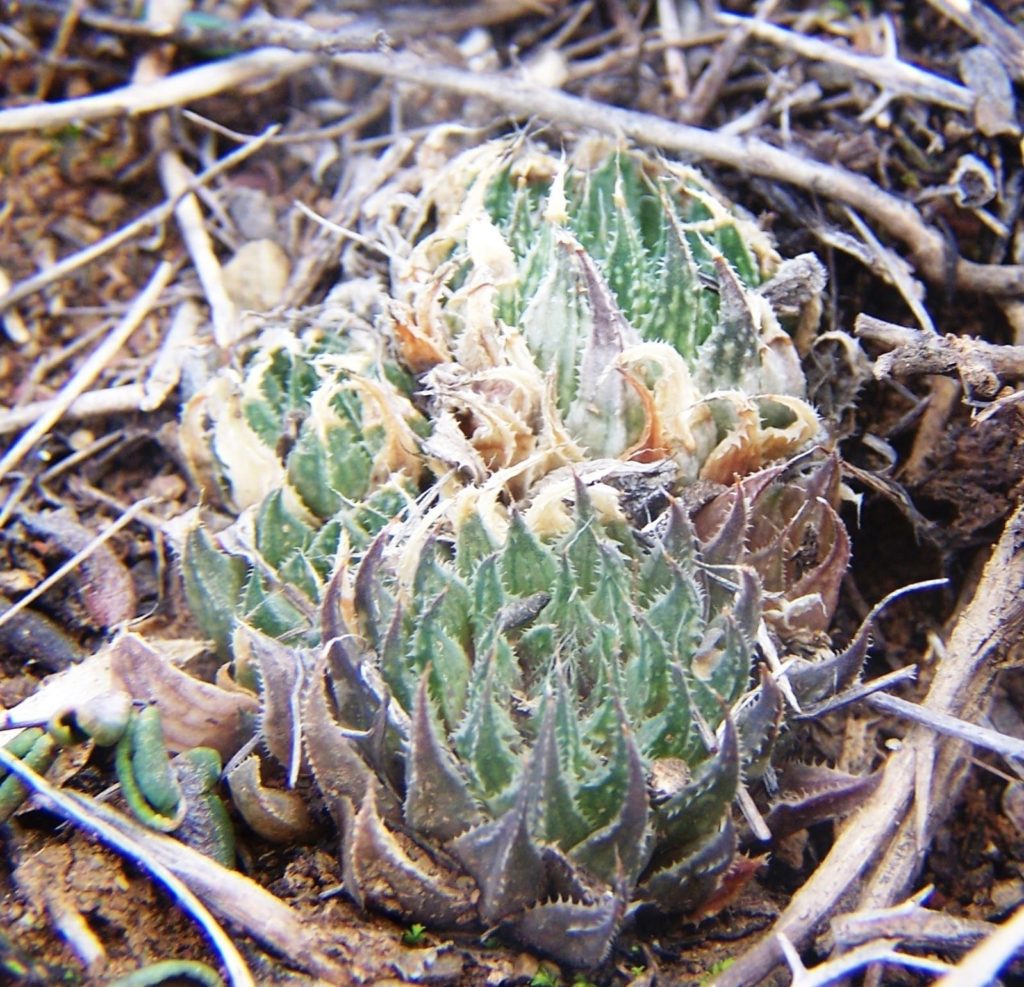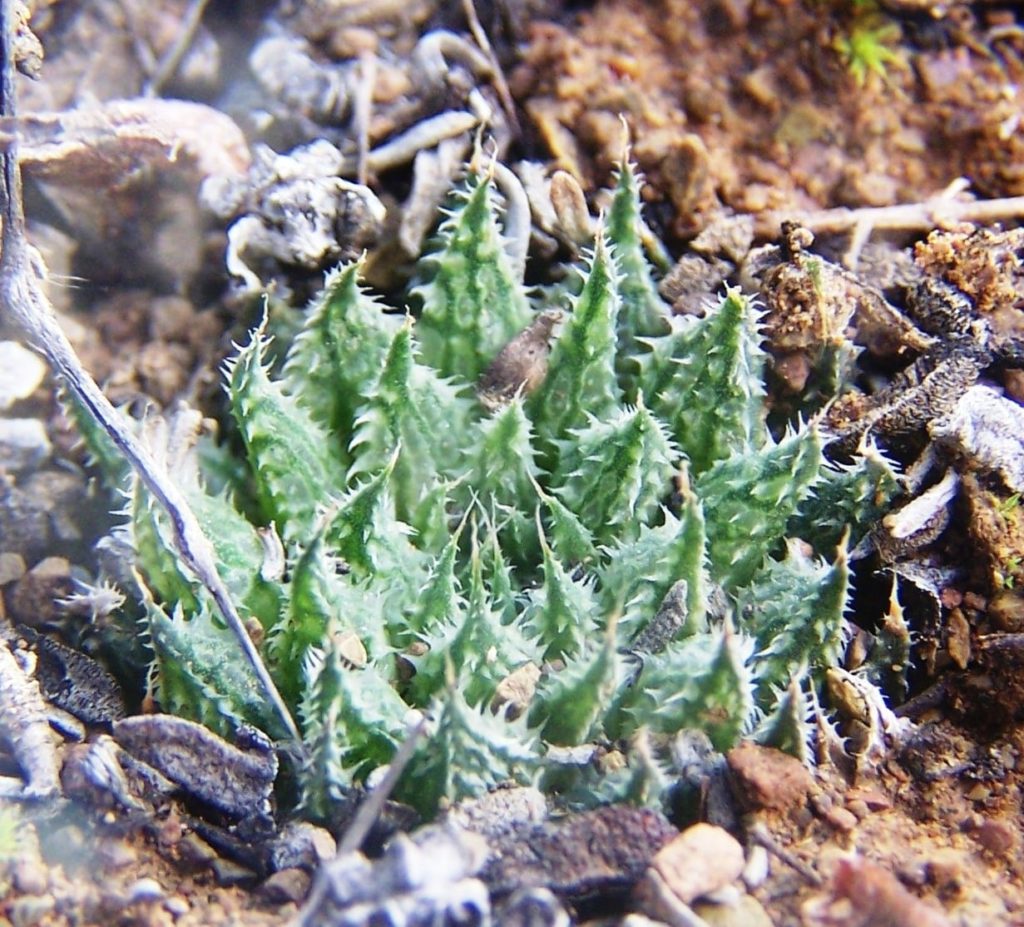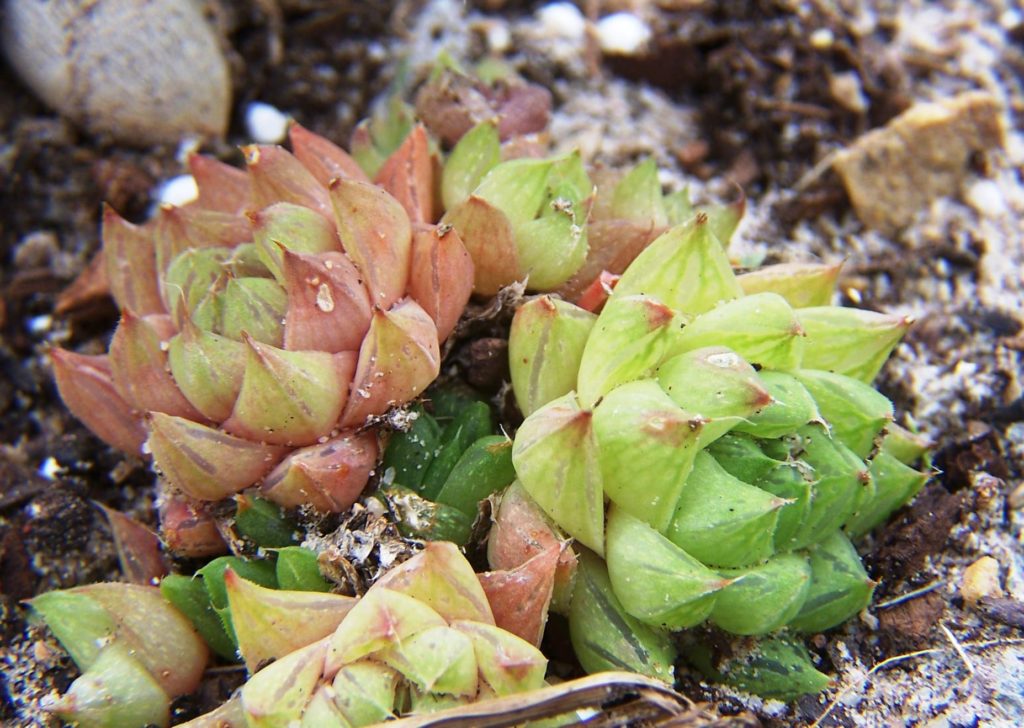20. Haworthia marumiana Uitew., Cact.Vetp. 6:33(1940), Nat.Cact.Succ.J 9:20(1947). Bayer :133(1976). Bayer :23(1982). non Scott :78(1985). Type (see B&M): Cape, Ladismith and Mossel Bay, Stellenbosch 6610 and 7773 (AMD).
marumiana: in honour of Dr M. van Marum.
Rosette stemless, very proliferous, to 7cm φ. Leaves erect, incurved, softish, margins and keel with spines, purplish-green in colour, opaque, with reticulate patterning. Inflorescence simple, to 200mm. Flowers smallish, white.
1982 – The distribution of this species is most interesting. Uitewaal gave the locality as Ladismith and also a second locality at Mossel Bay, both attributed to H. Herre. A collection in the Kirstenbosch garden attributed to C. Luckhoff also appears to have been this species, and this was recorded as from Heidelberg, Cape. Smith did not apply the name to any of his field collections. The recorded localities are not borne out by any other records or collections and thus the origin remained something of a mystery. In 1972 Mr C. McMaster informed the writer of a species growing in the mountains south of Tarkastad, and this proved to be the missing species. It is a small very proliferous species and the only tetraploid so far recorded in the subgenus Haworthia. The distribution is rather surprising as it occurs north of Tarkastad itself, at Cradock, Graaff-Reinet, New Bethesda, Murraysburg, Nelspoort and Beaufort West. It is very possible that H. pearsonii may also have been this species as specimens of H. marumiana do have brown‑striped flowers. However, this is not certain and H. pearsonii is regarded still as insufficiently known. It is possible that H. batesiana is a glabrous form of H. marumiana. H. archeri may be a southwestern variant of H. marumiana also, although the distance between known localities of these two species is rather great. On the other hand the known localities of H. marumiana are also very disjunct.
1999 – Col. Scott again has a fairly valid point that H. archeri is actually the original H. marumiana particularly in respect of the localities associated with the latter name. However, my contention expressed in several of my early writings, is that interpretation of species based on illustrations or only descriptions, with no solid herbarium record, are the foundations for contention. If I could extend this argument I would add that proper weight must also be attached to the concept of a species which has distribution range and variation. Secondly I also based my opinion on the plants received from several different sources as well as on plants in Smith’s collection ostensibly of the type, which I would have assigned to H. marumiana as I recognised it, and not to this southwestern counterpart. Smith’s plants of this species were from various sources including Uitewaal. Thirdly, it is evident from the herbarium record that the Stellenbosch Garden collection of Herre had included plants from the Nuweveld mountains at Beaufort West. I could not locate the representative specimen which Scott cites (Scott 6354) in the PRE herbarium. This species must also be considered together with H. cymbiformis var reddii in the Cathcart/Queenstown area. H. marumiana is now regarded as a very variable and widely distributed species of the Central and Southern Karoo.

a.var. marumiana.
The range of this species has been extended considerably since even the New Handbook. Several collections have been made far north of Queenstown and these are as different from the typical variety as var. archeri. There seem to be two different elements. One is from Sterkstroom and the Penhoek Pass in which the plants are quite large and with fine patterning on the leaves. Other collection from north and northwest are of plants with more succulent turgid leaves, and somewhat more translucent in the leaf reticulation.
Distribution: 3124 (Hanover): 32km E. Murraysburg (-CC), Bayer (NBG); Krugerskraal (-CD), Branch 315 (NBG); Aasvoelkrans (-DC), Bayer 2356 (NBG). 3125 (Middelburg): Elandsberg, N. Cradock (-DC), James 178 (BOL). 3126(Queenstown): Sterkstroom (-BC), Bruyns 5043 (BOL); N. Tarkastad (-BD), Smith 3075 (NBG), Bayer 2038 (NBG); Penhoek Pass (-DA), Bruyns 5031 (NBG); Andriesberg (-DA), Galpin 2245 (BOL, PRE). 3221 (Merweville): Tierberg (-DD), Bayer 5209 (NBG), Bruyns 2880 (BOL). 3222 (Beaufort West): Wagenpadskloof (-AD), Shearing 1224 (PRE); Karoopark (-AD), Branch 42, 298 (NBG); Stolshoek (-AD), Bruyns 3381 (BOL); Molteno Pass (-BA), Bayer 2373 (NBG), Bruyns 2949 (BOL); Beaufort West (-BA), Smith 5394 (NBG); Nelspoort (BB), Grant in KG18/70 (NBG). 3224 (Graaff Reinet): Valley of Desolation (-AB), Muller-Doblies 78/134 (NBG), Bayer 2347 (NBG). 3225 (Somerset East): Mt. Zebra Nat.Park (-AB), Branch 45 (NBG); Karreebos (-BA), Long 1152 (PRE). 3226 (Fort Beaufort): Spring Valley (‑AB), Bayer 172 (NBG)
Inadequately located: ex hort, Smith 6940 (NBG); Cradock, Archer 873 (BOL).
b.var. archeri comb.nov.
H. archeri Barker ex Bayer, JS.Afr.Bot. 47:791(1981). Bayer :29(1982). H. marumiana sensu Scott :78(1985). Type: CAPE-3320 (Montagu): Whitehill (-BA), Archer in NBG 68145 (NBG).
archeri: for Mr J. Archer.
1982 – The specimen of H. archeri in the Compton Herbarium was suspected of originating anywhere but in the Whitehill area until collected there by Peter V. Bruyns in 1977. It is a very small compact brownish green species reaching to 60mm in diameter. The relationship to other species is very unclear and the other species in the same subgenus occurring in that area are H. arachnoidea, H. pehlemanniae, H. lockwoodii and H. wittebergensis. An affinity with H. magnifica is highly unlikely because of the geographic barrier and floral differences. It is very conceivable that it is related to H. marumiana which is, however, also not known nearer than in the Nuweveld mountains at Beaufort West. Vegetatively the plants are almost identical to H. marumiana from as far afield as Tarkastad and Graaff-Reinet, and it is primarily floral differences and geographical distribution which justify its recognition. It grows on Dwyka sandstones among karroid vegetation but on the cooler south slopes. The Whitehill area west of Laingsburg is north of the Witteberg mountain range and technically lies on the border of the winter and summer rainfall areas. However, it is most probable that H. archeri prefers a dry summer and what little moisture it can get, in the winter. H. archeri is not proliferous, as is H. marumiana, and is so far unknown in cultivation.
1999 -The manuscript name by Miss Barker was intended for Mr Archer who initially curated the Karoo Botanic Garden when it was still situated at Whitehill. This element has proved decidedly more common than first supposed and also proven to be very proliferous. It has been since also found at several places in the greater Sutherland, Merweville, and Frazerburg areas, and this seems to confirm the connection with H. marumiana. The two varieties come very close together geographically at Prince Albert too, where some populations are still within recognisable range as var. marumiana (albeit with more distinctive patterning on the leaves). The reticulate patterning on the leaves in the var. archeri appears to be generally finer than is the case with var. marumiana and the leaves are less flaccid., but the var. archeri has less marking on the leaves than is generally the case. The leaves also tend to curve outward and are a little more scabrid. The var. archeri thus is fairly common on the higher-lying areas between the Rooiberg Pass (S. Laingsburg) and to well north of Sutherland. There is a high degree of variation across that range, and one collection from near the Floriskraal Dam is glabrous and very like a small glabrous form of H. arachnoidea var. nigricans. There is also a population in the Gamkapoort area which has broader leaves and less spination. The flat elevation of the upper petals seems to be distinctive and there is an odd occurrence of the petal presentation in some populations where the plants would otherwise be regarded as simply H. arachnoidea.
Distribution: 3221 (Frazerburg): Tafelberg (-AA), Bruyns 4846 (PRE); Riethuisies (-AD), Bruyns 5970 (BOL); Oukloof Pass (-BB), Bruyns 3995 (BOL); Langberg (-CA), Bayer 2453 (NBG); Klipfontein (-CC), Bruyns 3109 (NBG). 3320 (Montagu): Baviaan, Laingsburg (-BA), Bruyns 1405 (NBG); Matjiesfontein hills (-BA), Archer in NBG68145, Scott 3420 (PRE); Ghaapkop (-BA), Bruyns 1664 (NBG). 3321 (Ladismith): Bosluiskloof (-BC), Bruyns 3723 (BOL).
Inadequately located: ex hort, Whitehill (NBG).
c.var. batesiana (Uitew.) Bayer comb.nov.
H. batesiana Uitew., Nat.Cact.Succ.J 3:101(1948). Bayer :101(1976). Bayer :30(1982). Scott :100(1985). Type (see B&M): Cape, Graaff-Reinet, Ferguson (AMD).
batesiana: in honour of G. Bates.
1982 – As it is presently known, H. batesiana is an unusual and distinctive small species of up to 5cm in diameter recorded from the Valley of Desolation near Graaff-Reinet. It is smooth, bright green with a light reticulate pattern on the leaves. It also offsets very freely to form large clumps. A recent collection by Prof. D. Muller-Doblies from the Valley of Desolation consisted of still smaller darker green plants (up to only 25 mm in diameter) in a tighter rosette of spined leaves. These clearly belong to H. marumiana and also fit into the distribution pattern for that species. The writer has not succeeded in finding H. batesiana in the field, but a collection from Klipplaat northwest of Cathcart is clearly comparable. However, the plants there are too robust to be regarded as H. batesiana and it appears that there is a tendency towards H. cymbiformis. The possibility of H. batesiana being only a glabrous variant of H. marumiana cannot be ruled out; this is also suggested by a collection of the latter species from south of New Bethesda.
1999 – Several collections of this variety are now known. These are by J. Bouwer in the Valley of Desolation, a collection by P.V. Bruyns from the Kamdeboo mountain, and another collection also by P.V. Bruyns from Tandjiesberg to the east of Graaff-Reinet. In both these latter collections the plants vary quite considerably and are all glabrous. The Klipplaat (Waterdown Dam) population is assigned to H. cymbiformis var. reddii.
Distribution: 3224 (Graaff-Reinet): Valley of Desolation (-AB), Hurling and Neil in NBG68978, Smith 6955 (NBG), Bouwer (NBG), Scott 985 (PRE); Kamdebooberg (-AC), Bruyns 2978 (NBG); Uitkomst (-AD), Bruyns 2994 (NBG); Tandjiesberg (-BC), Bruyns 3245 (NBG,BOL).
d.var. dimorpha comb. nov.
H. archeri var. dimorpha Bayer, JS.Afr.Bot. 47:793(1981). Bayer :29(1982). Type: CAPE-3320 (Montagu): Constable Station, W. Laingsburg (-AD), H. Hall in Smith 7418 (NBG).
dimorpha: two shapes.
1982 – The variety dimorpha (of H. archeri) has much fewer leaves, which in cultivation both grow much larger (up to 120 mm diam.) and flex outward. This variety grows west of the typical variety and occurs in fynbos vegetation on Table Mountain Sandstone.”
1999 – Not much more light has been thrown on this variant. There has been no evidence of a connection to H. nortieri to the west. There have been some indications that a hard spinescent form resembling H arachnoidea occurs which has the same floral characters. Attention should perhaps be paid to the block patterned reticulation that occurs in the seed capsules of this species and also in H. pulchella. Interestingly, the same white tubercles which characterise this variety, also occur in the population of var. archeri cited above from Riethuisies in the Frazerburg area.
Distribution: 3320 (Montagu): Constable Station, W. Laingsburg (-AD), H. Hall in Smith 7418 (NBG).
e.var. viridis var.nov.
Type: CAPE-3322 (Oudtshoorn): S. Prince Albert, Bayer 3620 (NBG, Holo.).
virida: green.
Differs from the typical in being light-green with narrower, more-erect leaves. (A var. marumiana foliis erectis angustioribus subviridibus differt).
Plants collected by P.V. Bruyns at Vrischgewaagd west of Prince Albert, are brighter green than normal and the rosettes are fairly tight and reminiscent of H. pulchella, which is a much more scabrid species. The reticulate patterning on the leaves is still apparent.
Distribution: 3321 (Ladismith): Vrischgewaagd (-BD), Bruyns 6252 (BOL).SW. Kliphuisvlei (-BD), Thompson 2166 (PRE). 3322 (Oudtshoorn): S. Prince Albert (-AC), Krige (BOL), Bayer 3620 (NBG), Bruyns 2601 (NBG).

